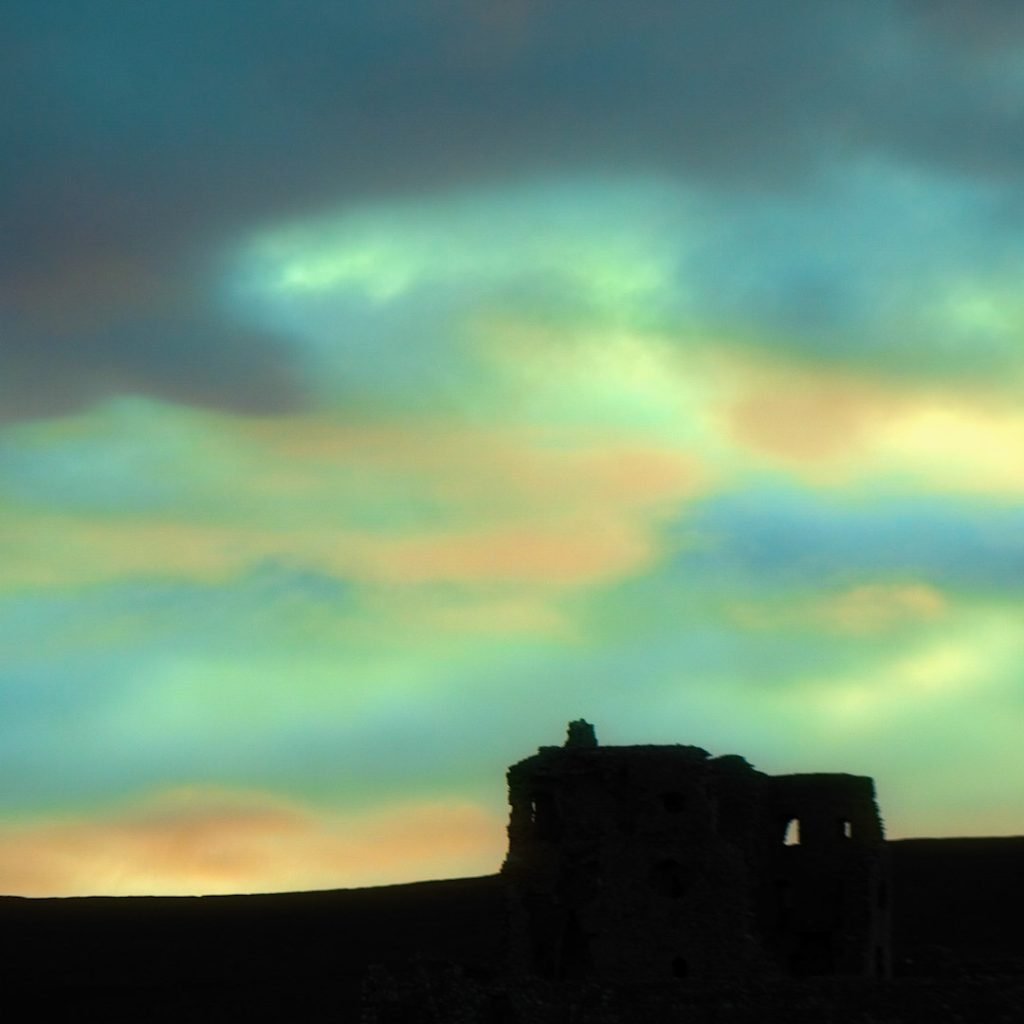Sand, Silt, Flint: Walk One: Auchindoun Castle
Sand, Silt, Flint is a studio album and song cycle project by Aberdeenshire electronic music composer, sound artist and avant-folk experimentalist Fiona Soe Paing.
From the bleak expanses of The Lecht in the Cairngorms, to the dramatic Banffshire coast, the songs combine Fiona’s original electronica arrangements and mesmerising vocals with re-imaginings of traditional ballads, archive material, field recordings and traditional instrumentation, enveloping the listener in an immersive and unsettling re-imagining of ancient stories.
Each song is also presented via a series of outdoor geo-located sound walks in the Echoes mobile app; using smart-phones and headphones, the audio is triggered by GPS, enabling audiences to experience the music in the environments which provided it’s inspiration. Each walk is accompanied by text detailing the local folklore that inspired it and practical information on how to get to each location.
Walk One: Auchindoun Castle
Little is known of Auchindoun’s early history. It’s thought to have been built in the 1470s by the architect and master mason Thomas Cochrane, a favourite of King James 111 of Scotland. Further fortification was made in 1509 when the castle is recorded as being owned by Sir James Ogilvy who in this year granted Auchindoun to his nephew, Alexander Oglivy.
In 1567 Alexander’s son sold the castle to Sir Adam Gordon, a kinsman of the Earl of Huntly. It’s during his ownership that the history of Auchindoun takes a dark turn and becomes associated with one of the most atrocious acts committed as part of Scotland’s notorious clan feuding.
Following victory over his rival John Forbes of Towie at the Battle of Craibstone in 1571, Sir Adam Gordon ordered an attack on Corgarff Castle (see The Lass o’ the Lecht walk), which, at the time, was affiliated with the Mackintosh clan and owned by Forbes. Forbes was away when Gordon’s men arrived and his wife Margaret Campbell refused them entry. In retaliation they burned Corgarff killing Margaret, her children and servants. Revenge attacks followed by Willie Mackintosh on Auchindoun for both the burning of Corgarff Castle and the murder of James Stewart, Earl of Moray by the Earl of Huntly. In 1594 Sir Adam Gordon was killed at the Battle of Glenlivet and Auchindoun sold back to the Oglivy family and passed between owners through Civil War and Restoration. During the first Jacobite uprising in 1689 Auchindoun undertook brief service as a temporary headquarters of the Jacobite army. However, by 1725 Auchindoun lay derelict and many of the stones from the castle’s walls were removed and used in the construction of nearby buildings.
Much of the clan feuding and deep Catholic/Protestant rivalry between the Gordon and Forbes families is recorded in the rich ballad tradition of the region. Including the burning of Auchindoun and Corgarff castles. The burning of Corgarff is remembered in the ballad of Edom o Gordon, while the burning of Auchindoun is immortalised in ‘Turn Willie Macintosh.’
Auchindoun Castle Walk
The dramatic ruins of Auchindoun Castle crown a small hill in the heart of Scotland’s whiskey trail in Speyside and strike a lonely, windswept pose over the River Fiddich.
It’s a 15 minute walk from car park to the castle along track and grassy pathways that lead through the surrounding farmland to the ruins. On leaving the car park follow a wide rough track that heads slightly uphill past clusters of lodge pole pine, sitka spruce and aspen trees to a farmhouse. Once at the farmhouse, a signposted gate points the way to a grassy track from which the ruins can be clearly seen up ahead. Head through a couple more gates and along a short track lined with ash, elm and sycamore trees that lead in procession towards the castle.
On breezy days a keen wind funnels across a landscape of wild heather, home to pheasants, herds of wild deer and active wind turbines. Once inside castle ruins the remains of Auchindoun’s high curtain wall protects visitors from the strongest of winds.
The castle is in effect a large tower house that rises across a number of floors, the most impressive of which, even in a ruinous condition, is a great vaulted hall on the first floor. Auchindoun’s rough lichen covered walls hold the memories of winters, summers, feasts and battles and it’s worth taking time to explore the nooks, crannies and remains of old fireplaces on the ground floor – the only floor accessible to the public. Although watch your footing on the uneven ground and look out for fenced off sections.
Alongside the romantic ruins, the views of the surrounding Moray countryside are well worth the walk to experience and best taken in through the large, long and empty windows and doors that punctuate the remains of the castle’s curtain wall – watch out for the steep drop on one side. From this vantage point it’s easy to imagine the journey of Willie Mackintosh and his men en route to Aunchindoun to seek revenge for the burning of Corgarff, and the bitter clan rivalry that shaped the history and fabric of both castles.
Practical Information
Getting There
Auchindoun Castle is maintained by Historic Environment Scotland. It is open year round and there is no charge for entry. The ruins are located two miles south of Dufftown in Moray off the A941, the main road between Dufftown and Rhynie (postcode: AB55 4DR). Turn onto a signposted farm track off the A941 that leads uphill to a small car park where the walk begins. They are not accessible via public transport.
Toilets & Refreshments
There are no facilities at the car park, the grounds inside the castle walls make for a quiet and sheltered spot for a picnic. The nearest refreshments and public toilets are located in Dufftown. Alternatively, about six miles south of the ruins off the A941 at Lower Cabrach is The Grouse Inn. Part of Speyside Whiskey folklore, the inn is famous for its outstanding whiskey collection with around 235 on optics and in total over 700 to choose from. The Inn’s tearooms are open 10am – 6pm Saturday to Thursday and 1pm – 6pm on Fridays.
Accessibility
The path to the castle is uphill, rocky in places and wet sometimes. It is not accessible for wheelchair users. In the winter it can also be icy. Good walking shoes or boots are recommended.
Sand, Slit, Flint is also presented can a series of outdoor geo-located sound walks in the Echoes app, using smart-phones and headphones, the audio is triggered by GPS enabling you to experience the music in the environments which provided inspiration. Each walk is accompanied by the above text. Scan this QR code to access the song and walk for Auchindoun Castle.

Each walk is written and researched by Lesley Anne Rose. https://lesleyannerose.co.uk
You purchase Sand, Silt, Flint via Fiona’s Band Camp
Image credit: Isla Goldie
Walk Disclaimer
We are not responsible for the maintenance of the pathways and tracks described in each walk. The responsibility lies with the landowner or public body that manages the land. Walks have been researched and written based on the conditions of the track or pathway when we undertook each one. We strongly recommend wearing appropriate walking shoes or boots and outdoor clothing for each walk.
Dogs should be kept on a lead during lambing season (April to July) and be careful to check for ticks when returning from walks between March and October which can cause Lyme Disease. For more information, see: https://forestryandland.gov.scot/visit/activities/walking/check-for-ticks


